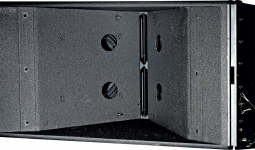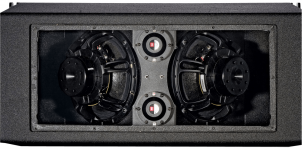@Ro808 You are here now? I thought you would of chimed in when I suggested using dual 18"s in a large BR crossed at 200hz to the horn.
Every now and then there are other things that take too much time 😉, but I'll read and respond.
View attachment 1115933
OK i see the plateau down there, now....
I miss things sometimes, I just want to make sure that....Large box'es with Large BR ports, can't be used in the midrange.....Right?
359L with 500cm2 port....Bad midrange, only good for subwoofer aye?
View attachment 1116032
This largely depends on woofer size and construction. In your case I hardly see any obstacles for a direct radiating (BR) sub solution up to approx. 300 Hz.
Of course, (over)excursion must be taken into account, something that can be overcome by using more cone surface (and a protection measure against 'accidents').
what exactly? is anyone else confused, plz let me know, which part exactly, I did not explain clearly. So that I can elaborate. Cause I really want to know your opinions.
I may be forgetting what it is that you don't already know, causes one to explain things, as if you already know the backstory, etc.
My woofer section is in the picture above. I am contemplating, an alternative configuration known as TMM. Also pictured above
The excursion of a TMM with 18"s plus the planned rear subs...looks like this at 116db/1(green)
View attachment 1116273
The reason I am contemplating this is because I am much more confident that I will be able to cross over the Axi+Horn at 200hz. I am trying to weigh pros and cons of switching the woofer section to Dual 18"s vent tuned to 22hz. I forced FR flat on the above Green plot. Excursion is below 1.5mm with the vented 18"s at 116db/1m
The Dark Blue line is actually 4 15" sealed, representing that portion of the spectrum, if I kept my current set up, and added rear subs. it is not forced flat but is rolled off at 65hz with a 4th order Hp in addition to the natural roll off.
In light blue is 8 sealed 18"s representing the current sub section (pictured above) plus rear subs that I have yet to build.
Everything is at 116db/1m force flat, except for the sealed 15, which is 116db/1m but with a roll of at 65hz.
In trying to nit pick the designs, I suggested that the PPSL has some phase flipping that limits the amount of summing/coupling to occur between the PPSL and the 15" sealed mid in their crossband. With dual 18"s on the face of the enclosure they would sum about perfect from 200hz down to cutoff.... I could theoretically fix phase with dsp and the PPSL would sum better with the 15. Potentially. I haven't tried in simulation yet, to get a picture of what can be done. The PPSl has usable output to 200hz it could play to XO if desired.
Once again, if I chose a TMM, excursion is still very low in comparison to my current configuration... It would be also, essentially, "Simpler"....We have talked about how, Simple, in an engineering perspective, is desirable.
So woofer section faceoff......
sealed 15+Sealed or vented 18' PPSL
vs
Dual Vertical stacked 15's in really big box tuned to 22hz, lightly dampened.
all while trying to including rear subs to show final excursion.
Makes me wonder what these projects look like 😉
The "planned rear subs" are to compensate for room influences I assume? Otherwise this should fullfill anybody's bass needs, except for lovers of 64 feet organ pipes, earthquakes and rocket launches.
Last edited:
YesThe "planned rear subs" are to compensate for room influences I assume?
Following the visit to the local audio show and the experiences with 'slightly larger and more sensitive than average' 2-way hi-fi speakers, I was inspired to see if such acclaimed systems could be improved at a considerably lower cost.
I selected 2 woofers, which seem suitable for the job. The concept implies a relatively high sensitivity - still fairly low efficiency though, so that a tube amp. or a quality A/B amp (like the Topping LA90) will suffice in most living rooms.
Both woofers in 80l BR tuned @ 40 Hz @ 40 W Power:


Both are budget woofers, the first from a respected professional audio manufacturer, while the second woofer is made in China and about 50-60% cheaper (and Le is 10x lower).
For comparison, the woofer that's used in a lauded, but very expensive 2-way system. Same cabinet size and tuning, but 65 Watts to achieve the same SPL:

I selected 2 woofers, which seem suitable for the job. The concept implies a relatively high sensitivity - still fairly low efficiency though, so that a tube amp. or a quality A/B amp (like the Topping LA90) will suffice in most living rooms.
Both woofers in 80l BR tuned @ 40 Hz @ 40 W Power:
Both are budget woofers, the first from a respected professional audio manufacturer, while the second woofer is made in China and about 50-60% cheaper (and Le is 10x lower).
For comparison, the woofer that's used in a lauded, but very expensive 2-way system. Same cabinet size and tuning, but 65 Watts to achieve the same SPL:
Last edited:
Of course this is desirable, but there are some response irregularities in the upper region of the usable range, which are also visible in the measurements of the commercial 2-way speaker.
As previously stated by Dr. Geddes, the midrange should ideally be as clean as possible. My selected woofers need to be crossed lower for optimal directivity matching. However, the response is cleaner, even in the optimal xo region of the latter, least efficient woofer.
Last edited:
A Jericho J1-94 clone? 😉 (Still my favorite Danley Product).
View attachment 1111314
I believe a stripped down redesign could potentially make it a very capable hi-fi or studio speaker. A single BMS 4594Nd + 4x 4" or 6" + 4x 15" or 18" should suffice. And while it works, I'd rather get rid of the combiner and instead optimize the throat section and possibly add curvature to the horns.
I'd probably also convert the low section to this; remove 2 and bring the remaining 4 closer together:View attachment 1111323
Although I have serious doubts about severe manipulation of wavefronts for hi-fi applications - bearing in mind the 18Sound XR1496 in the
Ø Audio Icon, this concept appeals to me.
Attachments
Just noticed Erin deleted the m2 decay measurements from this thread, and his website🙃
Even my threads asking him to share them are gone....
Even my threads asking him to share them are gone....
Why? Or how do they compensate for room influences? And to what extent?
If you put them inverted and delayed against the back wall, then yes.
multusub approach or DBA, I'll be using rear subs in some type of way to improve FR in the modal region.Why? Or how do they compensate for room influences? And to what extent?
If you put them inverted and delayed against the back wall, then yes.
If you decide to try both options, the comparison is especially interesting. And SBA is the third 😉..multusub approach or DBA
Art Welter's SynTripP with regular throat.

A smaller vertical acoustic load angle to increase power transfer, similar to radial horns.
Perhaps not coincidentally, the woofers are the same as the first of the 3 woofers I referred to a few posts ago.

A smaller vertical acoustic load angle to increase power transfer, similar to radial horns.
Perhaps not coincidentally, the woofers are the same as the first of the 3 woofers I referred to a few posts ago.
There is a lot of conflicting things in that message.Most - thankfully not all, of today's pro drivers are designed for durability, power handling and small enclosures.
As a consequence Xmax and Mms have increased, resulting in lower Qts and, more importantly, lower η₀ .
'Coincidentally', my preferences for woofers also go hand in hand with low Le and GD.
An higher Mms will result in an higher Qt, never a lower.
Based on my professional experience, the efficiency have been gone up, Qt go down but most importantly the vast majority of woofers are a lot more lineair. Demodulation (a lower Le) was never a thing from the past.
Group delay is just plain weird to point out without context.
But heh, what do I know right, after 15 years of working with B&C in high quantities ....
The biggest of all, efficiency is NOT a function of EQ of freq resp.Please let me second the request to hear the errors/misconception you think we should be aware of..
Efficiency is a function of (input) power. Quite a fundamental mistake.
EQ things changes the overal response, but it does NOT changes the efficiency of a system.
The explanation of the compression driver itself is a little too simplified, therefor missing some important details.
This is VERY well explained in the Loudspeaker Handbook by John Eargle, so I am not gonna explain that myself.
Go have a read there, from page 165 and onward.
But obviously people should know this book by now from the heart I must hope at the bare minimum.
If you don't know this book, (or a similar equivalent) I am not gonna bother debating.
I went back and re-watched the vids based on your comment.The biggest of all, efficiency is NOT a function of EQ of freq resp.
Efficiency is a function of (input) power. Quite a fundamental mistake.
EQ things changes the overal response, but it does NOT changes the efficiency of a system.
I think you mistook a comment about maximizing sensitivity, and extrapolated it to efficiency. (yes, i know they are related. but not the same....)
At any rate, I think he correct about sensitivity.
If sensitivity is defined as a broadband average measure across a driver's processed response curve, which I believe is the correct way to measure sensitivity, then yes...DSP flattening will maximize honest realizable sensitivity.
I use the method of finding sensitivity by measuring average rms voltage vs average SPL(z), over the same prolonged time interval.
Full band pink passed through all processing in place.
Real world honest measured sensitivity. Sometimes I measure average amperage over the same time interval, and determine true nominal impedance.
Any other method imo, such as the typical manufacturers' eyeballing curves response curves and making a sensitivity judgement call etc, .....is comparative BS.
Fulcrum Acoustics specs includes measured sensitivity with processing in place......
Yes, John Eargle's book is a great resource.
Excellent info on CD's and phase plugs.
Gunness is simply using todays measurement techniques and DSP tools to advance them..
I think that you should think that statement through. In a linear system the efficiency must be independent of input power. Your statement could only be true for a highly nonlinear system. "Quite a fundamental mistake."?Efficiency is a function of (input) power. Quite a fundamental mistake.
But basically they are the same, just different ways to express he same thing, different units, but one can be derived from the other.I think you mistook a comment about maximizing sensitivity, and extrapolated it to efficiency. (yes, i know they are related. but not the same....)
- Home
- Loudspeakers
- Multi-Way
- Is it possible to cover the whole spectrum, high SPL, low distortion with a 2-way?

